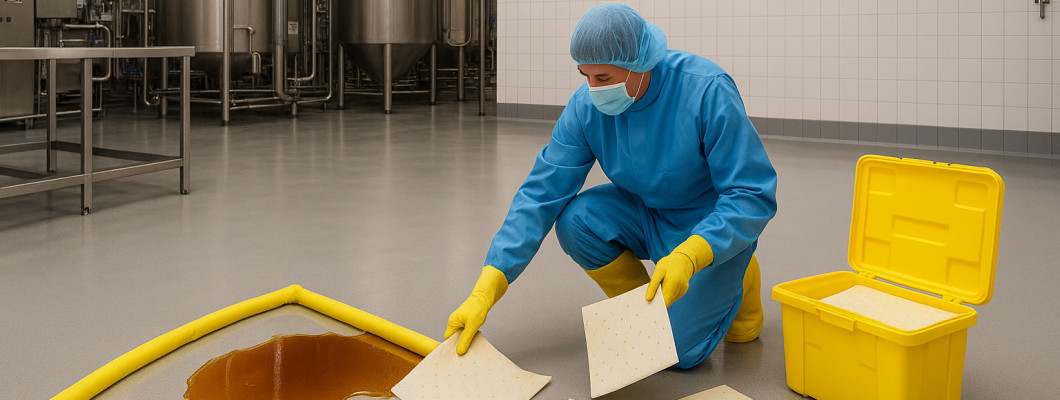
Allergen-Safe Spill Control in Food & Drink Manufacturing
In the fast-paced world of food and drink manufacturing, spill control is not just a matter of cleanliness; it is a critical component of allergen management, hygiene, worker safety, and brand protection. Effective spill management helps prevent cross-contamination, ensuring products are safe for consumers and compliant with industry standards.
Context: The Importance of Spill Control
Spills can introduce allergens into products unintentionally, posing serious risks to consumers, especially those with food allergies. A single oversight can lead to severe health implications, legal repercussions, and damage to your brand’s reputation. Comprehensive spill control measures are essential for maintaining a safe production environment.
Regulatory/Compliance Backdrop
In the UK, compliance with HSE (Health and Safety Executive) guidelines, COSHH (Control of Substances Hazardous to Health), and the Environment Agency's expectations is paramount. These regulations ensure that food manufacturers implement adequate controls to manage spills, particularly those involving allergens.
Integrating spill control with HACCP (Hazard Analysis and Critical Control Points) frameworks is essential for identifying potential allergen hazards. This approach supports compliance with BRCGS (British Retail Consortium Global Standards), which outlines best practices for food safety.
Hazard Mapping
In food and drink manufacturing, typical liquids that may pose allergen risks include oils, brines, syrups, flavourings, and CIP (Cleaning in Place) chemicals. Understanding where these substances are used helps in hazard mapping and identifying cross-contact vectors.
High-risk zones to focus on include:
- Intake: Where raw materials are received and processed.
- Batching: Mixing of ingredients, increasing the risk of cross-contact.
- Cook/Cool: Processes that could introduce allergens during temperature changes.
- Packing: Final stage where cross-contamination can occur if spills are not managed.
- Warehousing: Storage areas that need spill control to protect products.
Controls: Effective Spill Management Solutions
To mitigate allergen risks, utilise food-safe, low-lint absorbents, including those made from plant-based fibres. These products are effective in containing spills without adding contaminants.
Implement colour-coded kits aligned with hygiene zoning to ensure absorbents are easily accessible and readily identifiable. Key spill management controls include:
- Drain Protection: Use drain covers to prevent spills from entering drainage systems.
- Bunding: Create bunded areas for storage of hazardous liquids.
- Drip Trays: Place under equipment to catch leaks and spills.
- Spill Pallets: Use for bulk liquid storage to contain potential spills.
- Anti-Static Considerations: Essential when working with flammable substances.
- Housekeeping and Cleaning Validation: Regular checks to ensure cleanliness and compliance.
Kit Strategy
Selecting the appropriate spill kit is crucial. Consider the following:
- Type: Oil-only, universal, or chemical kits depending on the substances handled.
- Size and Placement: Ensure kits are adequate for the area they are intended to serve, and easily accessible in case of emergencies.
- Restock and Maintenance Routines: Regularly check and replenish kits to ensure readiness.
- Signage and Access: Clear signage should direct staff to spill kit locations.
Procedures & Training
Establishing Standard Operating Procedures (SOPs) for spill response is essential. This includes:
- Allergen-Aware Spill Response: Ensure staff are trained to handle allergen spills specifically.
- PPE: Personal protective equipment should be worn during spill clean-ups.
- Toolbox Talks: Regular discussions to reinforce spill management practices.
- Drills: Conduct spill response drills to test readiness.
- Near-Miss Reporting: Encourage staff to report near misses to prevent future incidents.
Waste & Evidence
Proper segregation and disposal of used absorbents is critical in maintaining compliance. Follow these guidelines:
- Segregation: Separate used absorbents from general waste.
- Disposal Methods: Adhere to local regulations for hazardous waste disposal.
- Records for Audits: Maintain logs of spill incidents, clean-up actions, and waste disposal for audit readiness. Record what to log and how often.
Practical Tools
To aid in compliance and spill management, utilise the following tools:
- One-Page Audit Checklist: Regular audits can help maintain standards and identify areas for improvement.
- Sample Spill Response Flow:
- Identify the spill.
- Assess the risk (allergens, chemicals).
- Notify a supervisor.
- Use the appropriate spill kit.
- Contain and clean the spill.
- Document the incident.
Mini Case Vignette
Consider a scenario where a syrup spill occurs on the production line. Without proper spill management, the syrup could come into contact with allergen-containing products, posing a risk to consumers.
Upon discovering the spill, the operator follows the established spill response protocol:
- The operator promptly alerts a supervisor.
- PPE is donned as per SOPs.
- The syrup is contained using low-lint absorbents from the colour-coded spill kit.
- The area is cleaned, and the incident is documented.
This proactive approach prevents cross-contamination and reinforces the importance of spill management in allergen control.
FAQs
- What types of spills are most common in food manufacturing? Oils, syrups, and cleaning chemicals are common spills that can pose allergen risks.
- How often should spill kits be inspected? It is advisable to inspect kits monthly and after any spill incident.
- What is the best way to train staff on spill response? Conduct regular training sessions, including drills and toolbox talks.
- How can we ensure compliance with HACCP regarding spills? Integrate spill management into your HACCP plan, identifying spill points as potential hazards.
- What should we do with used absorbents? Follow local regulations for hazardous waste disposal and maintain proper logs.
Conclusion
Implementing allergen-safe spill control measures is essential for maintaining compliance and protecting consumer safety in the food and drink manufacturing sector. By prioritising effective spill management, you not only safeguard your products but also uphold your brand’s integrity.
For tailored solutions in spill management, including a comprehensive range of spill kits and absorbents, explore SERPRO’s offerings at serpro.co.uk. Take action today to enhance your spill response strategy and ensure a safer production environment.
